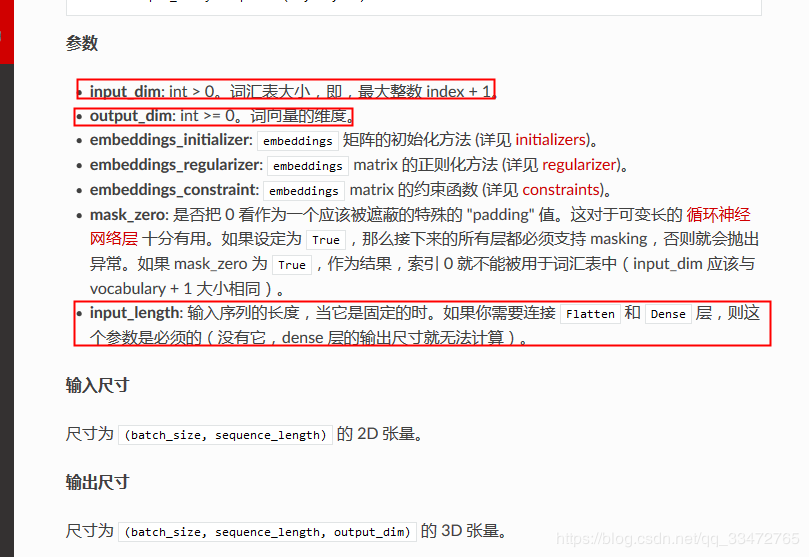Keras代码超详细讲解LSTM实现细节
1.首先我们了解一下keras中的Embedding层:from keras.layers.embeddings import Embedding:
Embedding参数如下:

输入尺寸:(batch_size,input_length)
输出尺寸:(batch_size,input_length,output_dim)
举个例子:(随机初始化Embedding):
from keras.models import Sequential
from keras.layers import Embedding
import numpy as np
model = Sequential()
model.add(Embedding(1000, 64, input_length=10))
# 输入大小为(None,10),Nnoe是batch_size大小,10代表每一个batch中有10条样本
# 输出大小为(None, 10, 64),其中64代表输入中每个每条样本被embedding成了64维的向量
input_array = np.random.randint(1000, size=(32, 10))
model.compile('rmsprop', 'mse')
output_array = model.predict(input_array)
print(output_array)
assert output_array.shape == (32, 10, 64)
具体可以看下面的例子:
from keras.models import Sequential
from keras.layers import Flatten, Dense, Embedding
import numpy as np
model = Sequential()
model.add(Embedding(3, 2, input_length=7))
#通俗的讲,这个过程中,Embedding层生成了一个大小为3*2的随机矩阵(3代表词汇表大小,,2代表没个词embedding后的向量大小),记为M,查看矩阵M:
model.layers[0].get_weights()
#输出
[array([[-0.00732628, -0.02913231],
[ 0.00573028, 0.0329752 ],
[-0.0401206 , -0.01729034]], dtype=float32)]
矩阵的每一行是该行下标指示的标记的数值向量,即矩阵M的第i(0,1,2)行是index为i的单词对应的数值向量,比如说,我的输入如果index=1,则对应的embedding向量= [ 0.00573028, 0.0329752 ],具体看下面:
data = np.array([[0,1,2,1,1,0,1],[0,1,2,1,1,0,1]]
model.predict(data))
#输出
[[[-0.00732628 -0.02913231]
[ 0.00573028 0.0329752 ]
[-0.0401206 -0.01729034]
[ 0.00573028 0.0329752 ]
[ 0.00573028 0.0329752 ]
[-0.00732628 -0.02913231]
[ 0.00573028 0.0329752 ]]
[[-0.00732628 -0.02913231]
[ 0.00573028 0.0329752 ]
[-0.0401206 -0.01729034]
[ 0.00573028 0.0329752 ]
[ 0.00573028 0.0329752 ]
[-0.00732628 -0.02913231]
[ 0.00573028 0.0329752 ]]]
data是Embedding层的输入,它包含2个batch,每个batch有7条样本,即data.shape = (2,7), 输出out的shape = (2,7,2),即每一条样本被embedding成了2维向量。
有时候我们可以用预训练好的embedding matrix初始化(使用百度百科(word2vec)的语料库):
def create_embedding(word_index, num_words, word2vec_model):
embedding_matrix = np.zeros((num_words, EMBEDDING_DIM))
for word, i in word_index.items():
try:
embedding_vector = word2vec_model[word]
embedding_matrix[i] = embedding_vector
except:
continue
return embedding_matrix
#word_index:词典
#num_word:词典长度+1
#word2vec_model:词向量的model
embedding_matrix = create_embedding(word_index, num_words, word2vec_model)
model = Sequential()
embedding_layer = Embedding(num_words,
EMBEDDING_DIM, #embedding后的向量大小
embeddings_initializer=Constant(embedding_matrix), #使用预训练好的embedding matrix初始化
input_length=MAX_SEQUENCE_LENGTH, #输入的每个batch中样本个数
trainable=False)
input = Input(shape=(MAX_SEQUENCE_LENGTH,), dtype='int32')
embedded_input = embedding_layer(sequence_input)
model.add(embedded_sequences)
其实Keras实现LLSTM(其它网络模型也一样),就像是在堆积木:
#单层LSTM
model = Sequential()
model.add(Embedding(len(words)+1, 256, input_length=maxlen))
model.add(LSTM(output_dim=128, activation='sigmoid', inner_activation='hard_sigmoid'))
model.add(Dropout(0.5))
model.add(Dense(1))
model.add(Activation('sigmoid'))
model.compile(loss='binary_crossentropy',
optimizer='rmsprop',
metrics=['accuracy'])
#model.compile(loss='binary_crossentropy', optimizer='adam', class_mode="binary")
model.fit(x, y, batch_size=16, nb_epoch=10)
y_= model.predict_classes(x)
#多层LSTM
model = Sequential()
#多层LSTM中,最后一个LSTM层return_sequences通常为false,非最后一层为True
#return_sequences:默认为false。当为False时,返回最后一层最后一个步长的隐藏状态;当为True时,返回最后一层的所有隐藏状态
model.add(LSTM(layers[1], input_shape=(seq_len, layers[0]),return_sequences=True))
#model.add(Dropout(0.2))
model.add(LSTM(layers[2],return_sequences=False))
#model.add(Dropout(0.2))
model.add(Dense(units=layers[3], activation='tanh'))
下面附上LSTM在keras中参数return_sequences,return_state的超详细区别:
一,定义
return_sequences:默认为false。当为假时,返回最后一层最后一个步长的隐藏状态;当为真时,返回最后一层的所有隐藏状态。
return_state:默认false。当为真时,返回最后一层的最后一个步长的输出隐藏状态和输入单元状态。
二,实例验证
下图的输入是一个步长为3,维度为1的数组。
一共有2层神经网络(其中第一层必须加上“return_sequences =真”,这样才能转化成步长为3的输入变量)
(1)return_sequences =True
from keras.models import Model
from keras.layers import Input
from keras.layers import LSTM
from numpy import array
from keras.models import Sequential
data = array([0.1,0.2,0.3]).reshape((1,3,1))
inputs1 = Input(shape=(3,1))
lstm1,state_h,state_c = LSTM(2,return_sequences=True,return_state=True)(inputs1) #第一层LSTM
lstm2 = LSTM(2,return_sequences=True)(lstm1) #第二层LSTM
model = Model(input = inputs1,outputs = [lstm2])
print(model.predict(data))
输出结果为:(最后一层LSTM2的每一个时间步长hidden_state的结果)
[[[0.00120299 0.0009285]
[0.0040868 0.00327]
[0.00869473 0.00720878]]]
(2)return_sequence = False,return_state = True
from keras.models import Model
from keras.layers import Input
from keras.layers import LSTM
from numpy import array
from keras.models import Sequential
data = array([0.1,0.2,0.3]).reshape((1,3,1))
inputs1 = Input(shape=(3,1))
lstm1,state_h,state_c = LSTM(2,return_sequences=True,return_state=True)(inputs1)
lstm2,state_h2,state_c2 = LSTM(2,return_state=True)(lstm1)
model = Model(input = inputs1,outputs = [lstm2,state_h2,state_c2])
print(model.predict(data))
输出为:
因为return_state =真,返回了最后一层最后一个时间步长的输出hidden_state和输入cell_state。
[array([[ - 0.00234587,0.00718377]],dtype = float32),array([[ - 0.00234587,0.00718377]],dtype = float32),array([[ - 0.00476015,0.01406127]],dtype = float32)]
(3)return_sequence = True,return_state = True
from keras.models import Model
from keras.layers import Input
from keras.layers import LSTM
from numpy import array
from keras.models import Sequential
data = array([0.1,0.2,0.3]).reshape((1,3,1))
inputs1 = Input(shape=(3,1))
lstm1,state_h,state_c = LSTM(2,return_sequences=True,return_state=True)(inputs1)
lstm2,state_h2,state_c2 = LSTM(2,return_sequences=True,return_state=True)(lstm1)
model = Model(input = inputs1,outputs = [lstm2,state_h2,state_c2])
print(model.predict(data))
输出为:最后一层所有时间步长的隐藏状态,及最后一层最后一步的隐藏状态,细胞状态。
[array([[[ - [2.0248523e-04,-1.0290105e-03],
[ - 3.6455912e-04,-3.3424206e-03],
[ - 3.66696041e-05,-6.6624139e-03]]],dtype = FLOAT32),
array([[ - 3.669604e-05,-6.662414e-03]],dtype = float32),
array([[ - 7.3107367e-05,-1.3788906e-02]],dtype = float32)]
(4)return_sequence = False,return_state = False
from keras.models import Model
from keras.layers import Input
from keras.layers import LSTM
from numpy import array
from keras.models import Sequential
data = array([0.1,0.2,0.3]).reshape((1,3,1))
inputs1 = Input(shape=(3,1))
lstm1,state_h,state_c = LSTM(2,return_sequences=True,return_state=True)(inputs1)
lstm2 = LSTM(2)(lstm1)
model = Model(input = inputs1,outputs = [lstm2])
print(model.predict(data))
输出为:最后一层的最后一个步长的隐藏状态。
[[-0.01998264 -0.00451741]]
本文参考自:
https://www.jianshu.com/p/a3f3033a7379
https://blog.csdn.net/qq_33472765/article/details/86561245
https://www.wandouip.com/t5i152855/
https://blog.csdn.net/weixin_36541072/article/details/53786020



